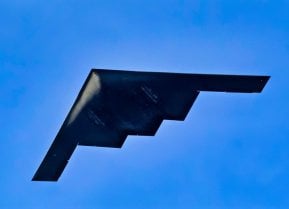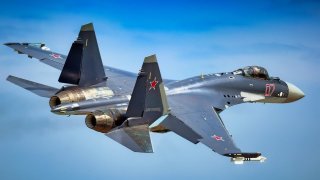Russia's Su-35 Fighter Nightmare Just Won't End
Over the past month, the Russian Aerospace Forces have faced significant losses, including more than a dozen combat aircraft, notably several Su-34 fighter-bombers and at least three Su-35 fighters. The Su-35, an advanced derivative of the Su-27 and intended for export, has been in Russian service since 2014 and seen action in Syria.
Summary: Over the past month, the Russian Aerospace Forces have faced significant losses, including more than a dozen combat aircraft, notably several Su-34 fighter-bombers and at least three Su-35 fighters. The Su-35, an advanced derivative of the Su-27 and intended for export, has been in Russian service since 2014 and seen action in Syria. Despite its advanced capabilities and designation as a "4++ generation" fighter, recent engagements have led to the downing of several Su-35s, with claims of at least one being a result of friendly fire. The Su-35 is praised for its versatility, maneuverability, and heavy armament but has faced criticism over its avionics compared to Western counterparts. The recent losses highlight potential vulnerabilities in its design and operational deployment. As of December 2022, Russia had 110 Su-35s, with ongoing production to replenish its forces.
Russian Su-35 Fighters Downed: A Blow to Aerospace Prowess?
Over the past month, the Russian Aerospace Forces have lost more than a dozen combat aircraft, including several of its highly touted Sukhoi Su-34 fighter-bombers, but it was just last week that at least three Sukhoi Su-35 fighter was reported to have been shot down in the past month.
According to reports on social media, the Su-35 disappeared from radar near Mariupol. The Russian Ministry of Defense has not confirmed the loss of the jet, and its downing hasn't been independently verified. However, the loss of another Su-35S was confirmed last month near Avdiivka – and there are reports that it may have been the victim of friendly fire.
As many as eight Su-35s may have been destroyed since Russia launched its unprovoked invasion of Ukraine just over two years ago.
The Su-35 Fighter from Russia in the Crosshairs
The Su-35 is noted for being a heavily upgraded derivative of the Su-27 aircraft (NATO reporting name "Flanker") that was originally intended for export. However, it has been in service with the Russian Air Force since 2014 and made its first combat deployment in Syria in 2015 – where it was employed to provide cover for other Russian aircraft on bombing missions. It was further utilized in guided and unguided strikes against ISIS and rebel forces in Syria.
Whereas the Su-27 was initially developed to address the development of the U.S. military's F-15 Eagle in the 1970s, the Su-35 was a response to the F-16. According to its designers, as a multirole fighter, the Su-35 can be used in a variety of missions and is capable of attacking ground and naval targets, including infrastructural facilities shielded by air defense systems, as well as those located at a considerable distance from home airfields
The Sukhoi Su-35 is actually the second improved version of the Su-27M; it is a single-seat, twin-engine, supermaneuverable aircraft. It reportedly features thrust-vectoring engines in place of the Su-27's canards. Designated the "Flanker-E" by NATO, this "4++ generation" fighter has been touted by Kremlin officials as being a very capable foe to current U.S. aircraft, including the F-15 Eagle, the F-18, and even the F-35 Lightning II.
According to United Aircraft Corporation (UAC), the Su-35 "combines the qualities of a modern fighter (super-maneuverability, superior active and passive acquisition aids, high supersonic speed and long range, capability of managing battle group actions, etc.) and a good tactical airplane (wide range of weapons that can be carried, modern multi-channel electronic warfare system, reduced radar signature and high combat survivability)."
Su-35: Well-armed Warbird
The Su-35's armament includes a GSh-30-1 30mm autocannon with 150 rounds, along with 17,630 pounds of payload on twelve external points. It can carry a variety of air-to-air, air-to-surface, anti-radiation, and anti-ship missiles, as well as a number of TV, laser-, and satellite-guided bombs. By comparison, the new U.S.-built F-22 has just four hardpoints on its wings and three on internal weapon bays.
The Su-35 is capable of employing an entire range of existing and future air-launched air-to-air and air-to-surface missiles, including precision weapons. It carries a 30mm GSh-30-1 gun, short-, medium- and long-range air-to-air missiles, Kh-31, Kh-35U or Kh-59M anti-ship missiles and various types of precision munitions and rockets as its basic armament. The fighter integrates the IUS-35 information and control system and a phased array radar capable of detecting targets at a range of 100 km-400 km.
It has a maximum take-off weight of 34.5 tons and can accelerate to 2,500 km/h. The Su-35 has an operational range of 1,500-4,500 km and a service ceiling of 20,000 meters. The twin Saturn AL-41F1S turbofans provide the Su-35 with maneuverability that can easily match or exceed the evasion techniques of nearly all existing fourth-generation fighters. With a maximum speed of 1,550 mph and a ceiling of 59,050 feet, it is a well-armed, speedy aircraft.
Yet, Ukraine has still managed to shoot at least a few of the Su-35s out of the sky.
One issue may be that the aircraft doesn't fully live up to the hype, a point noted by The Aviation Geekclub, which quoted aviation expert Abhirup Sengupta.
"Despite being marketed as 4++ gen, Su-35 has the least capable avionics suite among its competitors. It's the only major 4th gen. aircraft without an AESA radar or any form of Sensor Fusion. The Irbis-E is marketed as having a 350 km range against 3 m^2 target while in reality that's only in cued-search in a tiny FoV. What's rarely stated is that in normal volume search that range shrinks down to 200 km," noted Sengupta.
Moreover, the expert added, that "Su-35's radar has a maximum targeting range of 250 km – even for a B-52 like target," and further suggested, "The Su-35 is definitely the most capable Fighter in Russian Air Force and there is no doubt that it presents a serious threat to any 4th gen aircraft out there. But to say that it's on the same level as today’s F-15E, F/A-18E/F, Typhoon or Rafale, much less 'superior' is defying reality."
How Few Remain?
The Kremlin was believed to have had 110 of the aircraft in its inventories as of December 2022. It is in service with several fighter aviation regiments of the Russian Air Force, including the 22nd Guards Fighter Aviation Regiment.
Production of the aircraft is currently underway at the Komsomolsk-on-Amur Aircraft Plant located in the Russian Far East (part of the United Aircraft Corporation within the state tech corporation Rostec), and according to Russian state media, it delivered the latest batch of Su-35S fighter jets in July of last year.
Author Experience and Expertise: Peter Suciu
Peter Suciu is a Michigan-based writer. He has contributed to more than four dozen magazines, newspapers, and websites with over 3,200 published pieces over a twenty-year career in journalism. He regularly writes about military hardware, firearms history, cybersecurity, politics, and international affairs. Peter is also a Contributing Writer for Forbes and Clearance Jobs. You can follow him on Twitter: @PeterSuciu. You can email the author: [email protected].


